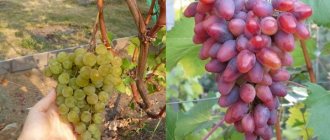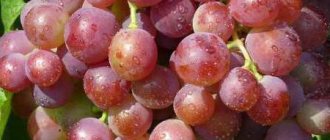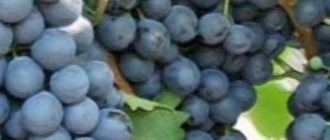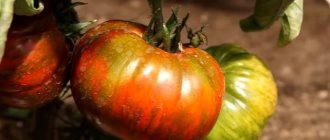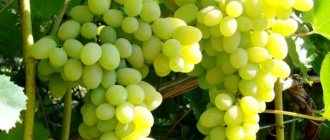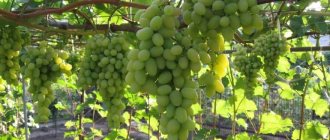The article presents Amur grapes: description of the variety, information on propagation, planting, care.
Today we will tell you about Amur grapes, which are considered very medicinal. And this amazing wild crop came to the European part of Russia back in the mid-nineteenth century. After this, noting the high frost resistance of the variety, breeders became interested in the grapes and began working with them.
The fruits of this plant have healing properties, which are actually the stuff of legends. Whether this is true or not, no one knows for sure. The berries of Amur grapes contain many substances that remove toxins from the human body, and this is confirmed by scientific research. Other varieties can also be grafted onto this grape, which is why gardeners love it, it is unpretentious and does not require care.
The grapes grow very quickly, occupying all the surrounding space. It is often planted near gazebos in order to create a beautiful hedge. In addition, this variety does not react to various emissions, so it does not need fundamentally clean air. The grapes will grow and bear fruit well even in unfavorable industrial areas.
History of the variety's creation
With the help of the creation of the Amur grape variety, biologist A.I. made a breakthrough in the history of domestic selection. Potapenko. He noticed the special properties of wild Amur grapes, which are able to thrive and develop in the difficult conditions of the Far East and Siberia. At the same time, it is not at all hampered by the poverty of local soils or the proximity of groundwater.
The wild form had enviable vitality and insensitivity to diseases of the cultivated vineyard. In addition, the plant was distinguished by abundant fruiting. Every winegrower in the country would dream of obtaining a variety with such characteristics.
Potapenko set out to develop a cultural form based on the potential of a wild relative, which would possess all its wonderful qualities. It is known that many varietal vineyards are grown using chemical treatments, since the crop is susceptible to fungal diseases and attacks by phylloxera, a dangerous pest of vineyards. But the breeder’s dream was to develop a variety that could produce a decent harvest without the use of chemicals.
And now, after half a century of intraspecific selection, a new grape variety - the Amur Potapenko hybrid - was obtained with all the declared characteristics. The variety was resistant to fungal diseases, and the grape pest phylloxera was defeated due to the fact that the new hybrid grew in regions where this pest simply could not survive.
Description
Amur, Ussuri or Manchurian grapes are distinguished by a very powerful vine, growing more than 10 m on a support. It has dark green leaves up to 15 cm long. The shape of the leaves can be whole, heart-shaped or three-five-lobed.
The early variety blooms in early June and is dioecious.
Attention! For a high-quality harvest, it is necessary to plant one male and several female specimens side by side, then pollination will be correct.
In the Moscow region and the middle zone, the fruits ripen in September and become almost black in color with a bluish tinge. The diameter of the berry is about 1.2 cm. The taste is pleasant, sweet and sour, and becomes sweet after freezing. Grapes are used to make wine, compotes, fruit drinks, jams and preserves. Young leaves are suitable for salads, soups and dolma.
There are several varieties, including Amursky Proryv, Amursky Potapenko, Amursky White, Amethyst, etc.
Amur grapes - a marvelous landscape solution
Amur white grapes: description and characteristics of the variety
Medium ripening grapes. It is suitable for both making wine and eating. The unpretentiousness of white Amur grapes is a gift for beginning winegrowers. Its shoots easily tolerate transplants and take root well in new places. In addition, the vine does not need additional shelter for the winter; it tolerates temperatures down to −40°C.
The variety has a conical bunch weighing up to 1 kg. The fruits are yellow and large, oval in shape, weight varies from 2.5 to 4 g. The grapes taste very sweet. Ripens in late August or early September.
Amur white is quite moisture-loving. It was bred from the Amur breakthrough variety and combines all the advantages of European table varieties and wild Far Eastern grapes.
Amur white grapes
Fact! The sugar content in fruits can reach 25%.
The liana is a powerful stem covered with leaves and loose clusters, which can curl to a height of up to 30 m; in just a year, growth can increase by 2.5 m.
Features of the variety
Amur grapes, the planting and care of which require certain conditions, are considered unpretentious. The plant loves loose and acidic soil. Strongly acidic peat is excellent as a fertilizer.
Peculiarities:
- Due to its good resistance to frost, it is used for breeding new varieties.
- It tolerates the first frosts well: they make the fruits sweeter.
- Excellent resistance to pests and diseases.
- Good yield.
- Thanks to its thick skin, it is easily transported.
- Bushes of overall dimensions.
- Used for landscaping.
Grape growers should remember that Amur white needs frequent pruning.
The benefits of eating grapes for women. Is there any harm from eating grape seeds? What is the difference between green grapes and black grapes?
Sustainability
Scientists were faced with the task of improving the frost resistance of grapes, as well as protecting them from common diseases. They coped with the task. Bushes do not need shelter for the winter. Young seedlings are more vulnerable and need insulation. Especially those that were planted in the fall.
Amur white grapes are resistant to various plant diseases, but spraying with special means is necessary. He practically does not suffer from mildew and oidium, but it is better to be safe.
Landing
Grapes can be propagated by cuttings, seedlings and seeds.
It is recommended to plant cuttings at the end of September. Although the variety is unpretentious, it is better to plant it in sunny areas not blown by the wind. You should not plant near trees; the vine can completely entwine them, thereby losing productivity. The cuttings are placed no closer than a meter from each other. Amur white is often propagated by seeds. The seeds are planted in the fall to a depth of about 1.5 cm, and after 30 days shoots can be seen. Planting seedlings is practically no different from planting ordinary grapes.
Care
Although the plant is moisture-loving, only young shoots need watering. Mature vineyards do not suffer from drought, although watering them will not be superfluous. The soil around the bush is mulched to retain moisture longer.
Does not require shelter for the winter; placement in greenhouses is contraindicated.
Amur grapes are fertilized once a year. You should constantly remove choking shoots. With proper care, this variety will last for many years, not only as a dessert, but also as a decoration for the area.
Productivity
It is not only frost-resistant, it has good taste, as well as high yield (3-4 bunches per shoot). To increase performance, it is important to control the height of the plant. An excellent solution would be to plant vines on a gazebo 2.5 meters high.
Features of cultivation
Amur grapes are unpretentious and prefer acidic and loose soils. Strongly acidic peat can serve as an ideal fertilizer for it. Requires pruning and tolerates it easily.
During the growing process, in the first couple of years, the bushes must be loosened and fertilized frequently. In the first year, pruning cannot be carried out, but subsequently pruning is not only possible, but also necessary. This will provide the fruiting arrows with optimal nutrition and help the vine form correctly.
And to prevent the branches from stretching, their tops are pinched, which directs nutrients not into growth, but into the formation of the crop. Pinching is carried out two or three days before the plant begins to bloom.
Important! Stepchildren should be removed, but only shoots that have not yet become lignified.
It is necessary to regularly remove leaves during fruit ripening, but only those that cover the bunches from the sun. It is allowed to pinch off no more than five pieces near each bunch, so as not to impair nutrition.
Amur grape seedlings
Amur grapes are often used for decorative purposes. An excellent solution would be to plant a seedling near an unsightly wall of an outbuilding, near a fence or gazebo.
Attention! During planting, the grape row should be positioned from south to north.
In this case, the depth of the hole for cuttings should be about 60 cm or a little more. A drainage layer of broken brick, expanded clay or pebbles is placed at the bottom, followed by a layer of river sand, humus and peat. You can add ash and a handful of superphosphate to the soil. You need to plant carefully, trying not to damage the root system. Afterwards, the bush should be watered and do not forget to form a hill of soil around the root collar.
When caring, the root system is fed in the spring with nitrogen-containing fertilizers, and in the fall with potassium-phosphorus fertilizers. It is necessary to water strictly to the very roots, but stop watering a couple of weeks before flowering. To prevent diseases, you can spray with Bordeaux mixture, which was used by winegrowers back in the 19th century.
Rules of care
A winegrower’s worries about caring for the vines do not become less labor-intensive with experience: Amur grapes, like any other, require constant attention. But this work is not a burden, and the result is a worthy reward.
Lighting and Humidity
Having chosen the right place for the grape bushes, the gardener solved half of the issues regarding lighting and humidity. But during the process of care, it may become clear that ornamental or fruit trees that have grown too large to the south of the vineyard cast a shadow on the grape plantings, and during prolonged rains, the water stagnates in the inter-row spaces.
To solve these problems, which affect the health of the vine and the quality of the harvest, provide free access to sunlight and drainage of excess water.
Watering rules
Amur varieties, originating from the humid Far Eastern forests, are very demanding when it comes to watering and do not tolerate drought. Watering is needed abundantly and regularly, especially in dry times.
Watering from a watering can
Pinching
In order for the vine to ripen better, it is necessary to fight with stepsons throughout the season: they are broken out as they appear. Experienced winegrowers recommend breaking out the stepsons not at their very base, but at the level of the second or third leaf. This will protect the main kidney from accidental damage.
Pinching the tops of Amur grape shoots is carried out at the very beginning of September to improve the quality of the harvest.
Trimming
Pruning of a powerful grape vine is necessary, otherwise the crop will get out of control and begin to subjugate the entire territory to its needs.
Grape pruning
Annual regular formative pruning will solve this problem:
- By the end of the first season, two strong, strong shoots are left - the future basis of the bush.
- In the spring, 3–4 buds are left on these shoots, removing all excess.
- By the end of the second season, new shoots develop from the remaining buds, of which a pair of the strongest ones are left. Everything else is cut out in the fall.
- On the “shoulders” formed over two years, overwintered shoots are shortened to 50 cm in the spring. By the end of summer, each vine, after similar careful selection, remains up to 12 healthy powerful shoots.
- In the spring of the fourth season, the formation of grape bushes enters the final stage. On each “sleeve” (two-year shoot), one upper shoot is left (this will be the fruit shoot) and one lowest shoot (replacement shoot), which is shortened to 3 buds. In this way, the fruiting link is formed. By autumn, up to 6 such fruit links are formed on each bush.
From the fifth year of life, most Amur varieties begin to bear fruit. The first harvest is formed on the fruit shoots. At the end of the season, these fruiting shoots are removed, and replacement shoots will bear fruit the following season. And this principle of pruning the vine remains for the entire life cycle of the grapes.
In addition to shaping, vineyards also require annual sanitary pruning: all damaged, shriveled shoots are removed.
Feeding with fertilizer
A properly charged planting pit will satisfy all the needs of young grapes in the first season. Subsequently, annual fertilizing in the spring with an emphasis on nitrogen, and in the second half of summer - potassium and phosphorus will ensure the growth of healthy grape bushes.
Fertilizer for grapes
Periodic watering with slurry diluted in proportions 1:5 during the period of flowering and fruit formation will serve as additional nutrition.
Diseases, pests
Amur grape varieties are characterized by resistance to diseases and pest damage. A typical pest of grapes from warmer regions - phylloxera - has not yet reached the Far East, and not all diseases of southern vineyards are familiar to gardeners from the banks of the Amur. But even in the homeland of frost-resistant grapes there are dangerous pests and serious infections.
Grape pests - bugs, weevils, moth, tubeweed, acacia false scale, spider mites - cause serious damage to vineyards if prevention is not carried out and control is not started in time.
To prevent the spread of pests, it is necessary to follow basic hygiene rules: the vineyard must be kept clean. Sanitary pruning at the beginning and end of each season, thorough cleaning of all fallen leaves (most often this is where the larvae overwinter).
Autumn sanitary pruning
To combat false scale, the trunks and “sleeves” of grape bushes are wiped with carbolineum, and the procedure is carried out in early spring. At the very end of the season or before the buds begin to bloom, the entire vineyard is treated with Bordeaux mixture or iron sulfate.
Pesticides that are effective in controlling pests are used no later than a month before harvest.
Grape diseases - anthracnose, mildew, powdery mildew, gray rot, spotting and bacterial canker - occur in conditions of high humidity against the background of temperatures that are too high or atypically low for the season. A neglected, weakened plant easily picks up an infection, which, spreading quickly, can destroy the entire vineyard. Prevention of diseases - proper planting and compliance with all conditions for caring for the crop.
If grapes are affected by infectious diseases, leaves and shoots with symptoms of disease are removed and burned, and all plantings are treated with fungicides according to the instructions.
Spraying grapes
Advantages and disadvantages
Amur grapes have many advantages. Among them:
- high yield of the variety;
- ripening of the vine simultaneously with the harvest;
- plastic;
- frost resistance;
- the vine will not reduce growth, even if the harvest is very good;
- ability to quickly recover from damage;
- excellent taste;
- the dense peel makes it easy to transport the fruit;
- resistance to diseases and pests;
- unpretentiousness and low maintenance requirements.
The following qualities are considered to be disadvantages:
- rapid growth, hence the need for frequent pruning;
- difficulties in harvesting, since it is not easy to cut bunches from a long vine.
Compared to the huge number of advantages, minor disadvantages are easily eliminated by timely pruning of bushes. The Amur grape variety is a real find for the harsh climate of the Far East, Siberia and other difficult climatic zones of Russia. Not only a bountiful harvest with a number of useful properties pleases the Russian gardener, but also the decorative nature of plantings is used in many personal plots.
Amur grapes have recently acquired legends about their healing powers and are spreading more and more widely. A powerful wild grape vine came to the European territory of Russia in the middle of the 19th century. Breeders, noticing the frost resistance of the vine - down to -40 0 C, began to work with it.
Amur grapes are popular for several reasons.
- Almost all parts of the plant have beneficial healing properties;
- Rich in antioxidants, including resveratrol, which removes heavy metals and toxins from the body;
- Cultivated grape varieties easily take root on the rootstock of the Far Eastern vine;
- The picturesque vine has won the hearts of many landscapers because of its ability to grow quickly, react little to smoke or exhaust emissions, and create beautiful corners in industrial areas, not to mention parks and courtyards.
Read also: What do you give your husband?
Description of the variety
The vine of wild Amur grapes can grow up to 20 m in length in its homeland, but in the European part of Russia it reaches more than 10 m. The leaves are large, up to 25 cm, of different shapes: entire, three-lobed, less often five-lobed, deeply cut. It blooms in July and attracts bees with its delicate aroma. Small round berries ripen in September, the weight of the bunches is 20-60 g. They taste sour, sometimes sweet and sour, sugar content is up to 10-12%.
Most Amur grape vines are dioecious plants, but there are also bisexual ones. On male specimens of bushes, flowers on a large (10 cm long and 2 cm wide) raceme, which looks like an elegant down jacket, appear earlier. Female flowers are distinguished by a clearly defined ovary. Pollination occurs with the help of insects and wind. The total yield of one vine ranges from 1.5 to 6-10 kg.
Grape propagation
Amur grape vines become impenetrable thickets not only because of their strong growth, but also because they easily propagate by seeds and layering. Bushes grown from seeds can vary in their characteristics, which is what breeders use. Propagation by cuttings, which guarantees the purity of the Amur vine species, is slightly different from that of cultivated grapes. Lignified cuttings do not take root well. And the green ones are the opposite. The vine begins to bear fruit at 6 or 8 years of age.
The growing season of the plant begins at a temperature of +5 0 C, in the middle zone - from the beginning or middle of May. Shoots stop growing in August. In four to five months, the vine grows stronger and, in a dormant state, is not afraid when it is covered with snow, since its development has long ended. Amur grapes take root well at the latitude of St. Petersburg. And in a snowless winter, the root of the Far Eastern grapevine is preserved. Therefore, this grape variety serves as an excellent rootstock for other cultivated vines.
Reproduction methods
Amur grapes reproduce:
- cuttings;
- layering;
- seeds.
The most common and effective method is still cuttings.
Seeds
When properly stored, the seeds do not lose their viability for many years. Most often they are planted in the fall. Before spring planting they need stratification. The seeds are deepened into pre-prepared soil by 1.5 cm. After 20-35 days, the first shoots appear.
Cuttings
Amur grape cuttings take root well. Before planting, they are placed in water with the addition of potassium permanganate or “Kornevin” for two days. At the bottom of the cutting, the bark is removed at a distance of about 3 cm, placed in wet sand and left at room temperature. Within three weeks, roots will emerge from the cuttings. Now you can transplant the grapes into cups with soil.
Air layering
The young vine is passed through a plastic bottle and filled with soil. After some time, the stepson will take root. After the vine has matured, it is separated from the bush and planted in a permanent place.
Landing Features
The wild Amur grape vine prefers acidic soils and does not tolerate the presence of lime in the soil. It develops well on drained soils if you put strongly acidic high-moor peat in the hole for the bush. It should be noted that vines of varietal plants love slightly acidic or neutral soils.
- Larger holes need to be prepared earlier;
- Up to 300 g of superphosphate and 100 g of potassium sulfate are added to them;
- Fill with compost and humus;
- Establish a strong support.
This grape variety is not planted under the house or near fruit trees due to its ability to quickly twine around any support.
If there is no pollinating vine, the berries will be without seeds, like sultanas. But this only applies to wild vines. Seedlings of different hybrid varieties bred on its basis will generally remain infertile.
Landing technology
Planting Amur grapes of white or black varieties is no different from planting other varieties and is not particularly difficult. By carefully following the advice of experienced winegrowers, even a beginner can cope with a crop that was once exotic for the harsh climate.
Planting grapes
Selection of seedlings
Dioecious grape varieties are planted with 2–3 female plants per male bush. Male and female bushes differ in the shape of the flower cluster, which means that it is impossible to determine this important characteristic from a cutting or young seedling purchased on the market. Therefore, a novice winegrower, who does not count on the honesty of sellers at spontaneous markets, buys planting material in nurseries where professionals grow and propagate the crop.
The optimal age of seedlings is 1–2 years.
When choosing a seedling, pay attention to:
To the roots . The root system is well developed, as evidenced by a large number of lateral roots and strong heel roots. Signs of rot (dark or brown spots, softened tissue), dryness and brittleness are a good reason to refuse the purchase. The roots should be dense, elastic, elastic. If possible, bite off the tip of the root with pruning shears: a light, juicy cut, like a raw potato, indicates a healthy plant.
Roots of grape seedlings
Stem . No mechanical damage, even bark color, at least 3 internodes - indicators of high-quality material.
Kidneys . It is necessary to have living buds, elastic, without peeling, firmly attached to the shoots.
Grape bushes purchased in the fall for spring planting can be stored in a cool basement at temperatures up to +5°C in moistened (but not wet!) sand.
Seedlings purchased in containers or other containers (closed root system) can also be preserved until spring by moistening the soil with regular spraying.
Immediately before planting, all root shoots are trimmed so that no more than 15–20 cm remain. If the root system is weak or some of the roots had to be removed (damaged or rotten), then pruning is not carried out before planting. Such a seedling should be kept in a root formation stimulator, then in a weak solution of manganese or treated with a fungicide. Shoots with a weakened root system are planted at an angle to stimulate the growth of lateral roots.
Planting a seedling at an angle
Time and place for landing
Amur grapes are usually planted in spring. For Siberia, this is the end of May - the beginning of June, when all the frosts are behind us. In the central regions, you can take up a shovel already in mid-May.
Less often, Amur grapes are planted in the fall. If in the conditions of central Russia, the time for autumn planting falls on the beginning - mid-October, then in Siberia planting begins at the end of August or the first half of September, if the autumn is expected to be long and warm. In any case, it is necessary to rely on forecasts: the plant must take root before the onset of stable frosts. This means that they need to be planted a month and a half before the cold weather.
The place for the vine is chosen to be sunny - the south side of buildings or an open, elevated place. It is worth paying attention to elevated areas in order to avoid washing away the soil when the water is high: for grapes, the optimal depth of groundwater is no higher than 2 m.
When planning planting along the walls of a building, it is necessary to protect the vine from drops of water falling from the roof.
If it is planned to build a support for the vine along the wall, then it should be taken into account that the plant does not like drafts, so choose the leeward side and do not place the vine at the corners of buildings, where air flows move freely.
Soil preparation
Amur grapes in the wild feel comfortable on loose, acidic soils that allow water and air to pass through well. Varietal samples prefer slightly acidic soil, closer to a neutral reaction.
The area for the vineyard is carefully dug up, cleared of plant debris, compost and humus are added, and the neutral soil is acidified with high-moor peat. In heavy clay soil, it is not recommended to make deep holes for planting grapes unless the soil structure is lightened: water, having difficulty passing through the layers of clay, fills the hole and stands in it during the prolonged rainy season, which leads to oxygen starvation of the root system of the grapes. Therefore, in clayey areas, the soil structure is improved by adding sand and peat and providing a good drainage layer.
A nutrient mixture of fertile soil, a bucket of compost or humus, flavored with superphosphate (2 tbsp. ) and wood ash (1–2 cups).
Preparing the planting hole
When planning to plant a vineyard in one row (this arrangement will ensure access of the sun to each berry), the pits are prepared at a distance of no closer than a meter. If the vineyard has several rows, then the recommended distance between bushes in a row is up to one and a half meters, and between rows - 2 m.
The ideal option is to prepare the planting hole in the fall, and charge it with ash and superphosphate immediately before planting. In the spring, part of the nutritious soil, moistened with melt water, is removed from the pit, which has settled sufficiently during the winter. The remaining soil is loosened and a landing site - a mound - is prepared for the seedling.
Installation of support
When planting in a hole, a peg is immediately installed, rising 40–50 cm above the ground, to provide support for the developing seedling.
The rapidly growing bushes of Amur grape varieties require reliable support. For vineyards planted along the walls, lattice supports are made - trellises made of wooden blocks. The distance from the wall should be such that the passage between the building and the bushes is sufficiently free. This will ensure ventilation of the grape bushes and make it easier to care for the crop.
Trellis for grapes
For a linearly planted vineyard, organizing a trellis is a simple matter, but necessary. Every 2.5–3 m vertically dig in wooden blocks or metal rods, reinforcement and pull twine, keeper tape, synthetic thread, wire - any suitable material. The lower level is 0.5 m, then in increments of 0.5 m.
Planting a plant
Before planting, the shoots of seedlings are shortened to 3–4 buds. A seedling is placed in a hole on a mound so that the lower bud is on the border with the soil surface. The roots are straightened, the hole is filled up, compacting the soil around the seedling, and a bucket of water is poured out. After complete absorption of moisture, nutritious soil is added; if the soil has subsided, the shoot is spudded with the same soil.
Healthy seedlings take root quickly, and as soon as the buds begin to bloom, the grapes are unplanted and the growing shoots are attached to the support.
Young grape bush
Vine care
The next two years after planting, the grapes are fed with nitrogen fertilizers in the spring, complex fertilizers in the summer and potassium-phosphorus fertilizers in the fall. The vine of the Amur grape variety is moisture-loving; the annual precipitation rate in its homeland is 700 mm. Therefore, watering is the main component in caring for this plant. Under natural conditions, the grapevine is located on the edges of forests, along river banks, and on the southern slopes of mountains. When growing Amur liana at home, you need to select sunny areas.
Vigorous Amur grapes require annual formation. It is recommended to grow the vine in a tall trunk, from which perennial branches extend, and from them - sleeves that are cut off every season. Thickening should not be allowed; pruning is done along green shoots that can be rooted. If young cuttings of wild vines have taken root, they tolerate winter well.
Planting the Amur vine in shady places threatens the grapes with powdery mildew. Also I.V. Michurin selected varieties of Far Eastern grapes that are resistant to phylloxera.
Offspring of a wild vine
Now in Russia, varieties of winter-hardy vines are grown, created after crossing wild Amur grapes with cultivated bushes: Korinka Michurina, Northern Black, Far Eastern, Buitur, Arktika and others. Northern viticulture also uses the results of intraspecific hybridization of Far Eastern grapes: a series of varieties Amur Potapenko, Ametistovy, Neretinsky, Odin (Amur breakthrough), Triumph. The success of the work was the production of bisexual varieties. These are Amursky Potapenko 1 and Aleshkovsky grapes.
The Amur Triumph grape vine has a promising future. Early ripening of dark pink berries in clusters up to 1 kg, fast growing season, and disease resistance make it a favorite of vineyards located in harsh climates.
Another success of breeders is the development of vine varieties with light berries. White Amur grapes are a dream that came true in the Zolotoy Potapenko variety. The berries have a very good sugar content - 25%.
Comparison with other popular varieties
| Variety | Amursky | Isabel | Alpha |
| Ripening period | 145-156 days | 150-180 days | 135-145 days |
| Frost resistance | Up to -40°C | Up to -29°C | Up to -30°C |
| Productivity | 8-12 kg | 23-40 kg | 10-14 kg |
| Bunches | 120-180 g | 140-180 g | 120-170 g |
| Taste | Simple, sweet | Sweet and sour with a hint of strawberry | Sweet and sour, “isabella” |
| Color | Black, with a whitish bluish tinge | Dark purple, almost black | Dark blue, almost black |
| Disease resistance | Above average | Above average | Above average |
| Shelf life | 2-3 months | 3 months | 2-3 months |
| Sugar accumulation | 18-23% | 17-19% | 15-18% |
| Acidity | 12-18 g/l | 6-7 g/l | 10-13 g/l |
Viticulture in the capital region
The Amur grape vine is easily grown in the Moscow region. The winding vine grows more than 10 m. This beautiful grape in a purple-gold mantle curls like a lush blanket over trees and country houses. It is not susceptible to disease, unlike cultivated varieties of southern vines. Leaves appear in the second ten days of May, when the temperature becomes above +6 0 C. It blooms at the end of June, shoots stop growing in July - early August. The berries are collected from the beginning of September, without delay on the vine - they may fall off.
Not everyone wants to care for delicate southern varieties, carefully covering the bushes for the winter. And the vines, whose ancestor was the Far Eastern liana, come to the rescue. Among the non-covering varieties for the Moscow region, Agat Donskoy, Moscow White, Muscat Dalnevostochny, New Russian, Sputnik, Alfa and others are popular. But still, winegrowers mulch the soil around the bushes, because snowless, frosty winters are not uncommon in these parts.
Popular hybrids
Ussuri grapes became the ancestor of a large group of northern varieties. The most famous:
- Marinovsky . The vine clusters ripen in early September. The berries are dark blue with thin skin, small, oval in shape. The taste of the fruit is slightly expressed, the aroma is weak.
- Amethyst . The variety's vines are bisexual. The harvest ripens in the last weeks of August. The dark blue grapes are juicy, have a pronounced sweet taste, and are round. Each shoot has four large clusters. The vine begins to bear fruit after planting the following year. Resistant to fungal infections. The berries of the variety do not attract wasps.
- Triumph . The harvest is harvested at the end of August. The berries are large, dark pink with a sweet taste and aroma reminiscent of pineapple. The fruitfulness of the vine increases with age.
- Agat Donskoy . It is valuable for winemaking. High-quality juices and wines are made from juicy, rich-tasting berries. Lianas are bisexual. The variety is resistant to common diseases.
- Neretinsky . Used by winemakers. Wine made from the berries of the variety has a memorable chocolate flavor.
- New Russian . An early ripening variety, harvested at the end of July. The berries are oval, red in color with juicy, fleshy pulp and delicate taste.
The “Proryv” variety is considered the pinnacle of achievements of breeders of northern grape varieties.
Siberian vineyards
The Primorsky and Far Eastern fruit and berry experimental stations made this strange phrase a reality a few decades ago. Nowadays, many varieties bred using wild Amur vine material are cultivated by winegrowers in Siberia. High-yielding, with high-quality berries, serpentine fruit vines of the varieties Amursky 1, Cheryomushka Sibirskaya, Black Seedless Winter Hardy, Taezhny, Vaskovsky No. 5, Bely Superranniy, Kozlovsky and many others are distributed in Siberian gardens.
Watch a video about growing grapes in Siberia
Grapes are known and loved in different parts of the world. It is grown both in garden plots and on plantations. The popularity of the plant is explained by the fact that its berries are suitable for making wonderful drinks, confectionery, and raisins. The leaves of grape plants, which have beneficial properties, are eaten. One of the best representatives of this culture is the Amur breakthrough grape.
History of the variety
In the wild forests of the Far East and northern regions of China, a variety of grapes grows called Ussuri, and more often Amur. It has strong branches, matte wrinkled foliage that turns red-burgundy in autumn.
Grape bushes grow near streams and rivers. The size of its seedless fruits is approximately 2 cm. They are colored dark purple, more reminiscent of black. Grapes have a varied flavor range. There are plants with female or male flowering. They bloom at the end of May. The fruits appear on a grape bush that has a female type of flower. The grapes ripen towards the end of the last ten days of September.
Numerous experiments involving crossing local frost-resistant varieties led to the development of a new type of grape, frost-resistant and disease-resistant. From wild grape bushes of the Amur region by world-famous breeder A.I. Potapenko genetically produced a variety called Amur Breakthrough. It gave rise to varieties of frost-resistant grape crops.
The Amur breakthrough grape is found under the names Potapenko-7 and Odin.
Wild Amur grapes - the progenitor of the Amur breakthrough
Reviews of Amur grapes
If you have any doubts about Amur grapes, you should turn to the reviews of those who have already dealt with them.
- Elena Kotsenko : “Several years ago I decided to decorate the fence with some climbing plant and chose Amur grapes. In 2 years he has completely braided it and I am absolutely satisfied. In addition to its decorative appearance, it pleases with its huge harvests, and this despite the fact that I don’t take care of it at all! The harvest is mostly used for delicious wine.”
- Oleg Ovsyanko : “I love Amur grapes because they are not afraid of frost. Growing it is a pleasure - I remove the excess vines and water it, nothing else! Despite frosts in winter below -35, the vine never froze.”
- Vitaly Leshchenko : “We bought the Amur grape variety several years ago. At first the bush grew, then, when it seemed to be producing clusters, they were not there. And only then did I notice that his flowers were masculine. Last year we also planted a female bush nearby, I hope this year or next we will be pleased with the harvest!”
Description of the Amur breakthrough grape variety
This is a vigorous plant. The vine bush develops quickly. The shoots that appear in the 1st year are initially green, but in the autumn they darken and acquire a red tint. Many shoots are formed. In one season, a bush can grow 2.5 m. The grapevine, resting on trellises and building walls, stretches up to 35 m in a few years. The diameter of the trunk can reach 20 cm. The bark is thin and brown. Every year there is more and more detachment of it.
Read also Aloe juice for wrinkles around the eyes
The leaves are round or elongated in shape, with teeth at the edges, reaching 250 mm in length. On the reverse side of the leaf blades there is a short, light fluff.
In autumn, the foliage of the Amur Breakthrough grapes turns red, which looks very elegant
The berries of the Amur Breakthrough are round, dark pink, dark blue or purple in color. A bunch of grapes weighs on average about 300–400 g. Its weight is directly influenced by the growing conditions of the crop. Each berry weighs about 4 g. Its size is approximately 15 mm.
The berries are larger than wild grapes, but the increase in size has weakened the dark pigmentation, making them paler.
The skin of the fruit is dense. The taste of the juicy sweet pulp is pleasant. The fruits are well transported and are not damaged by wasps. The Amur breakthrough grape variety is similar in properties to representatives of the Far Eastern varieties: Amethyst, Triumph, Neretinsky.
Potapenko was able to improve the taste of the berries of local wild grapes and make the resulting variety useful both for table consumption and for use as a valuable raw material in the production of quality wines, juices, compotes, and jams. Essential oils and coffee substitutes are obtained from berry seeds.
The Amur breakthrough is distinguished by its increased sugar level - 23%. This value is also significant for a number of southern varieties.
Amur breakthrough grape berries - with thick skin, juicy pulp, pleasant taste
Features of the variety
Amur breakthrough resists frost better than all grape varieties. In mature plants, the vine can survive outdoors at temperatures of -40°C. This quality allows such grapes to be grown in the Northern regions and the Far East. The variety has also gained popularity in the regions of central Russia.
Grapes are not afraid of spring frosts. After them, he quickly recovers. Even if individual branches freeze, the shoots that replace them will bear fruit. A feature of the Amur Breakthrough grape is its increased need for moisture. The development of the variety is negatively affected by dry climate and summer drought, so the plant must be watered in a timely manner.
Amur breakthrough grapes produce good yields with sufficient moisture
The variety has an average degree of resistance to various diseases, but can be susceptible to the dangerous fungal disease mildew (downy mildew), characteristic of European grape varieties.
Productivity
The grape bunches ripen towards the end of summer. The yield of this variety is good. More than 10 kg of fruits are harvested from one bush.
Since the bushes are capable of developing rapidly, grown perennial plants with an arbor shape can produce up to 100 kg of yield.
About the offspring of grapes
Currently, many varieties of winter-hardy grapes are grown in our country. They are obtained by crossing with other cultivated bushes. For example, with Arctic, Northern black, Far Eastern grapes and others. Great success has been achieved by Far Eastern breeders who cross heat-loving grape varieties with winter-hardy ones, obtaining interesting specimens.
Many gardeners praise the Amur grapes called Triumph. As you understand, this is the pinnacle of selection. Its berries ripen very early, and up to one kilogram of ripe fruit is collected on the tassels. In addition, this variety has a fairly fast development cycle, so the fruits are obtained more than early. It can be grown even in harsh climates, where it is already resistant to diseases and pests. It is often called a favorite among many grape varieties for its excellent characteristics.
Another interesting variety of Amur grapes is White. As you understand, it has very light fruits, so the berries literally glow in the sun. It also has a high sugar content, so there is more than enough sweetness in this variety.
In central Russia, namely in the capital region, Amur grapes are often grown. Of course, its vines do not grow to the required 20 meters in length, but even in such conditions the grapes develop well. It is often planted near gazebos, where its vine forms interesting green hedges. The aroma in such a gazebo will be simply magical. Imagine reading your favorite book with a cup of tea, and clusters of berries glowing in the sun are singing above your head. What could be more beautiful? Grapes also climb beautifully on fruit trees, so they are often planted in gardens.
Leaves of this variety usually appear in late spring, when it becomes warm enough outside. The grapes bloom in mid-summer, at which time the shoots stop growing. The berries begin to be picked at the beginning of autumn; they do not fall off for a very long time. However, keeping them on branches for more than 2 weeks is also not worth it.
It is advisable to mulch the soil around the bush so that the moisture does not evaporate and weeds do not disturb you. Of course, these wonderful varieties should be looked after, but many Far Eastern grapes do not need to be covered for the winter. It is Siberian hardening that allows plants to withstand adverse natural phenomena.
Currently, there are many non-covering varieties sold on the market, so you can always choose what is right for you and your site. Now it will probably be unusual for you to hear about Siberian vineyards, but such exist. The painstaking work of breeders has made the dream of many gardeners come true, and even in the harshest climatic conditions this demanding crop can be grown. The Amur vine is considered to be the ancestor of these varieties. And now, even in Siberia, gardeners will be able to grow grapes and at the same time get a high yield.
Features of planting and growing
Amur breakthrough grapes are planted in different ways:
A plant obtained from seeds may lose the taste qualities inherent in the variety. In addition, fruiting with this method of planting occurs late: you have to wait from 3 to 5 years. Therefore, it is easier to grow grapes from seedlings or cuttings.
Video: seedlings for planting
Illumination
When planting, you need to choose a well-lit area of land, for example, its southern, southwestern side - grapes love sunlight. It is preferable to plant vines along the border of garden property. Plants located along the same line will take up less space and will be better illuminated by the sun from all sides.
Grapes require a lot of light to ripen well.
Wind protection
During the period of fruit ripening, the grapevine does not tolerate wind well, especially cold wind. Therefore, on the northern edge of the site, they try to cover the plants with a wall or trees.
The soil
Any soil is suitable for growing Amur breakthrough, but it is preferable to choose loose, acidic soils that are moist and have good drainage. You should not plant grapes in an area where groundwater flows close to avoid washing away the roots, which is harmful to the crop.
Grapes grow worse on limestone lands, which tend to dry out quickly. When the soil on the site is alkaline, turf soil and peat are added to it. If there are buildings nearby, then water from the roofs should not fall on the plant.
On flat areas of land next to the ridges there should be furrows to drain water. On fertile soils, the roots of the plant develop well at first, but when the soil becomes waterlogged, they begin to suffocate. Excess moisture can be removed using deep holes in the ground with normal natural drainage, or perhaps artificial drainage conditions can be created.
Planting dates and scheme
The crop is planted after the soil dries and warms up. In the southern territories this occurs from May 5–20, in the northern regions the time for planting is the whole of June. If grapes are planned to be planted in two or more rows, then the distance between rows is 2 m, between plants - 1.5 m.
Preparation and planting of seedlings
Annual (biennial) seedlings with a well-developed root system and more than 3 internodes are used as planting material. The main roots of the planting material at the bottom of the cutting are cut off before planting, leaving 15 cm; remove all diseased and frozen roots.
When the main root system is underdeveloped, the roots of the nodes are left. In this case, instead of a vertical landing, an inclined one is carried out.
1–2 year old seedlings are used for planting
Together with the roots, the cutting is shortened, leaving 3-4 lower mature buds on it. The cut roots are immersed in a mixture of clay and manure (mash). After this, they take root better. If there is no such mixture, the roots are dipped in a container of water and the plant is left in this state until planting.
Before planting grape seedlings, dig a hole or a common trench under each of them, 0.8–1.9 m wide and no less than the length of the root shoots. The soil below can be loosened to the depth of a spade bayonet, and the bottom can be paved with drainage: sand, gravel, broken brick. Then, at the bottom of the pit, a mound is built from extracted soil, compost (10 kg), superphosphate (300 g), potassium salt (calcium chloride) or fertile forest soil (100 g).
For the convenience of planting grapes, you can dig not separate holes, but a single trench
A seedling is placed on top of a raised platform, distributing the roots along the entire circumference. Pour 10 liters of water into the recess. Then it is covered with fertilized soil to the very top. The bud located at the bottom of the seedling should be located at the same level as the ground surface. Once again, the planted plant is watered so that the soil settles. The top of the seedling is covered with fertile soil to a height of 4-5 cm, and hay and straw are placed. The role of mulch:
- retain moisture in the soil even in hot weather;
- prevent weed growth;
- protect plants from rodents.
The soil under the grapes is regularly loosened. During this time, the mulch is transferred, and after the work is completed, it is returned back. A trellis is installed near the plants for support. In its simplest form, it is simply a stick to which a vine is tied.
Video: mistakes when growing grapes
Making trellises
It is necessary to provide a trellis design that will last a long time and will not need to be changed.
- Pegs are prepared from long thick acacia branches or other material. The height of one is approximately 1.5 m.
- The outside is treated with resin to prevent rotting. The part of the pegs protruding above the ground can be painted or varnished.
- The pegs are driven into the ground, leaving a gap of 4 m between them.
- To make the structure more stable, additional supports are placed at the first and last peg.
- Stretch wire or ropes between all pegs in 2 rows. The location of the first row is 0.3‒0.4 m from the ground surface. The second row is pulled 0.3 m from the first.
For grapes you need to install a trellis
How to care for Amur breakthrough grapes after planting
In dry weather, the grapes are watered. In order to accelerate the growth and development of the bush, simultaneously with watering, fertilize with slurry diluted with water in a ratio of 1:5. Instead of manure, you can use a complex fertilizer containing phosphorus, nitrogen, and potassium (70 g of fertilizer per bucket of water).
You can simplify the procedure for watering the plant by installing a pipe with a diameter of 100 mm inside the hole when placing the shoot in it. Its tip should rise above the top of the soil. The planted sprout is watered through the hole. Water will go directly to the root system.
To water the grapes even while planting the seedling, you can install a pipe in the hole.
Read also Pancakes with missing kefir
The ripening of the vine is stimulated by breaking off the resulting stepsons. With the onset of September, the main shoots are pinched. In grafted branches, the roots that have arisen on the scion are cut off at the point of adhesion of the rootstock (main shoot) and scion (scion grafted to the main plant).
Formation of grape bushes
If the grape bushes are not given the necessary shape in time, then during their development the plant will develop many additional unnecessary shoots that grow chaotically. They harm future crops by consuming food. By year, the formation occurs as follows:
- In the 1st year, no more than 2 strong shoots are brought out, of which the base (shoulders) of the bush will consist, the remaining shoots, including the branches that appear in the places where the foliage of the left shoots grow, are broken off.
- In the spring season of the 2nd year, you need to leave 2-3 buds on one branch, and remove the rest of the branch.
- In the 3rd year, the 2 strongest shoots are left on each shoulder, cut off by 0.5 m, and the others are removed. These shoots will be the sleeves of the bush. During the summer season, 2-3 shoots are grown on each sleeve.
- In the spring of the 4th year, the upper shoot of each sleeve should be left for fruiting, cutting it off after 10-15 buds. The lower shoot is left for replacement; it is cut off, leaving 3 buds. Fruiting and replacement shoots will form the fruiting unit of the bush. In total, 4–6 fruit links should remain on the bush. Thus, fruitful shoots will develop from the buds of fruiting shoots next year, and new 2-3 shoots will be ready to replace shoots that have completed fruiting.
Subsequently, pruning of grapes is carried out in a similar way: on one of the shoots grown for replacement, intended for fruiting, up to 15 buds are left; on another shoot grown for replacement next year - up to 3 buds.
The bushes are pruned twice: in the fall before digging up the plant, in the spring after digging it up. For fruiting, you need to leave young annual shoots in such quantity that they have from 60 to 100 buds with the rudiments of inflorescences.
In the spring, the bushes are freed from shelter, shoots are pruned for replacement (by 2-3 buds), and the vines are tied to a trellis. The sleeves with fruiting branches are tied horizontally to the two lower rows of wire, and the shoots that will grow in the summer are tied vertically. During the summer period, all excess shoots and some shoots from the shoulders and sleeves are removed from the grape bush.
With the onset of September, in order for the vines to ripen better, chasing is carried out, which consists of removing the upper part of the shoots, 3 to 5 internodes (places where leaves are attached), from the shoots. If you do the chasing too early, when the bush is developing, many stepsons will form.
What does annual care of Amur breakthrough grapes include?
Some features of grape care:
- Each season begins with the removal of covering material. In spring, cold weather often occurs and snow falls. Grapes are a heat-loving crop, and the formation of juice requires a soil temperature of at least 8 o C. For the southern regions, such conditions are typical for the first ten days of May. If you open grapes too early, their branches and buds will begin to dry out and die. If you open the plant too late, the buds that have begun to develop may get stuck and break off when the covering is removed;
- Removal of the covering material is followed by pruning and “dry” (spring) tying it to the trellis. Sleeves are tied to the lower part of the support (wire or hemp twine), and hearth branches are attached above;
- Before the “dry” garter, the plant is pruned in order to form fruit-bearing branches of the bush. The fruit links of the current year's harvest consist of shoots that formed on replacement knots. On bushes of four branches, about 8 fruit links should be left. For this purpose, you need to save 2 low-growing shoots on replacement knots. The one above must contain at least 15 buds, the lower one (replacement shoot) - 4–5 buds. When forming fruit links, it is better to leave the shoots located at the bottom so as not to promote the growth of older parts of the plant, which will make it difficult to dig up the bush;
- Autumn pruning of grapes is best done while removing the branches from the trellis. Spring pruning is best done when the buds swell or begin to bloom;
- Amur breakthrough likes moist soil and needs timely watering. Water consumption is measured in 3 buckets per adult plant. When watering, it should be remembered that the crop does not tolerate when the roots are washed away. To prevent the flowers from falling off the plant during the flowering period, the plant does not need to be watered a week before.
Video: caring for Amur breakthrough grapes
Shelter for the winter
Amur breakthrough grapes are frost-resistant varieties. It is not covered at a temperature of -20°C. The exception is young seedlings, which should be closed in the first year after planting.
At lower temperatures, the grapes are covered. It is removed from the trellises in the winter so that they are covered with snow. Severe frost can destroy up to a third of the branches of the crop, but the remaining branches are quite enough for restoration and a good harvest. For this reason, grapes are sometimes grown without pruning.
The Amur breakthrough is resistant to frost, but in the northern regions it also requires shelter for the winter
Watering grapes
The Amur variety requires regular watering only when it is young, until its roots have fully developed. Mature vineyards of this variety are not afraid of drought, although spring watering will not be superfluous. In addition to watering, the soil is saturated with moisture by mulching the root zone with mowed grass. When it overheats, water and decomposition products of organic compounds enter the ground, and the energy released during this process provides the roots with heat.
Experienced gardeners install a drainage well when planting grapes nearby. The simplest option is a large plastic bottle with holes in the bottom. The container is filled with crushed stone, and a piece of hose is installed in the neck. The entire bottle is buried in the ground, only the neck with the hose rises above the soil level. When watering, water is poured into a hose, from where it flows through holes in the bottom of the bottle to the roots of the grapes. At the same time, the soil surface does not get wet, and the danger of the spread of fungal diseases decreases, and the water warms up as it reaches the roots. Another advantage of this method of irrigation is that it is economical; 2–3 times less water is added to the soil.
Option for installing a drainage well.
The first watering is carried out in the spring before the buds swell. The second watering is carried out approximately 2 weeks before flowering, and the next one 1–2 weeks after flowering. It is not recommended to water the grapes during flowering. The greatest amount of moisture is added during filling and ripening of berries. It is advisable to water with warm water. Before winter, water-recharging irrigation is carried out. You need to remember about the need for moisture recharging in the spring when there is a threat of frost.
On a note! This variety does not require shelter for the winter, as it tolerates even the heaviest frosts well. But the young seedling does not yet have such resistance, so it is better to cover it.
Since the bush of this variety grows very quickly, it requires constant pruning, otherwise it risks becoming an ornamental plant that does not produce a harvest.
Lack of constant pruning of the plant will lead to the fact that it will become simply decorative, with a meager amount of fruit.
But Amur grapes practically do not need fertilizer. It is enough to feed it once a year using mineral fertilizers.
To protect against diseases and pests, bushes must be sprayed with special solutions from time to time.
Reviews
In the village of Amursky Proryv we have 4 winegrowers. We concluded that he loves acidic soils (such are the case in his homeland), climate humidity and warmth, but not heat. We have a forest-steppe, dry, chalky soils, carbonates.
spotlight
https://forum.vinograd.info/archive/index.php?t-2864.html
So far I have one seedling of Odin; if you count the year of rooting, then it is in its third year. I'm waiting for the signal harvest. Last year, the bush did not really grow until July - it produced only 2 vines of 70 cm, and ripened after freezing. In the fall I was too lazy to cover it, I just pressed it to the ground, but all the buds overwintered. In the spring I had to break off all the lower ones and half of the upper ones. As of May 25, the growth is already up to a meter and more than half of the shoots have tassels - it’s time to normalize. So far I see the promise of the variety for landscaping a fence - powerful early growth, high declared winter hardiness and elegant leaves.
Sergey Sergeich
https://forum.vinograd.info/archive/index.php?t-2864.html
Amur breakthrough (One) - Amur. I have had one near St. Petersburg for seven years. One grows and ripens even in open ground on the Smolensk ridges. The first two years I covered it for the winter, then I stopped, there were no cases of freezing. I don’t apply any treatments at all, only in the spring with Bordeaux mixture. If you get mildew, it’s after the harvest. The wine turns out great. I myself am a former Khabarovsk resident, summer in St. Petersburg is far from being the same as in Khabarovsk, however, some grape varieties ripen well. Mainly inside the greenhouse, but also in the open ground, Odin, Boyarinov's Star, New Russian, Valiant ripen. But it is necessary to plant on the Smolensk ridges; there is still much less heat here than in Khabarovsk. But there are fewer diseases.
Alexander1955
https://plodpitomnik.ru/forum/viewtopic.php?t=620
The Amur Breakthrough grape variety should attract the attention of gardeners. It is good for growing in different climatic conditions, being an unpretentious and frost-resistant crop. In addition, the variety has a stable yield, large berries with a memorable taste and original foliage that decorates the garden.
Planting grapes
The agricultural technology used in the southern regions is not suitable for northern latitudes, so gardeners have created their own system of rules, and step-by-step instructions will help you understand them.
Lessons in growing grapes begin with proper planting. First of all, it depends on her whether the seedling will take root in a new place.
Optimal timing for planting in Siberia
Planting grapes in Siberia depends on the climatic characteristics of the region. Autumn is short here, and in September it may already snow. The seedlings will not have time to take root during this time.
Spring planting of grapes in Siberia is characterized by better survival rate of cuttings. In May, young bushes are placed in a greenhouse, because in June snow may still fall in some areas. Grapes are planted in open ground when the threat of frost disappears and the soil warms up to +15º.
Pit preparation
Planting grapes in Siberia for beginners in the spring includes several preparatory stages. Choose a sunny place for plants. They are not planted in areas where groundwater is close to the surface. Seedlings will not take root on saline soil either.
In order for the bushes to have time to get stronger in a short summer, you need to plant the grapes correctly in the spring; in Siberia, holes are prepared for them in advance. They are dug with a diameter of 80 cm to a depth of 70 cm to 1 m. The distance between seedlings is left up to 2 m.
Drainage is installed at the bottom of the pit (expanded clay, small stones, gravel). Many gardeners claim that the bush will need it only at the beginning of development, then the roots of the grapes will grow greatly and go beyond these limits. They advise covering the bottom of such holes with branches. Later they will rot and turn into fertilizer.
For the next layer, humus or compost is used, to which a complex of mineral fertilizers is added. They are especially needed in areas with clay and sandy soils.
The third layer consists of a mixture of sand, humus and garden soil. Then the layers are repeated in the same sequence almost to the very top.
Preparing seedlings for planting
The stages of planting grapes in Siberia for beginners include not only preparing the pit, but also young plants. The cuttings are carefully examined and sorted. If there is spotting or rot on them, the seedlings are removed. The upper part is cut off so that 6 buds remain.
When the air outside warms up to 15-18º, the grapes begin to harden. At first, the seedlings are taken out for 1 hour, but then the time is gradually extended. The day before planting, water the plants abundantly.
Sometimes bushes are sold with an open root system. They will take root better in a new place if you use a special talker. It is prepared from 1 part mullein and 2 parts clay. The root is first treated with a growth stimulant and then dipped in mash.
Landing
Planting depends on the growing method.
In the open ground
A small hole is dug in a hole prepared in advance. The pot with the bush should completely fit into it. The cutting is removed from the container and placed there at an angle. It is needed to make it easier to cover the shoots for the winter.
The seedling is sprinkled with earth and a hole is left for easy watering. Each bush requires approximately 1 bucket of water.
At the dacha, the gardener at this moment should have arcs on hand that can be covered with agrofibre. This will protect the plantings from return frosts.
In the greenhouse
The technology of growing indoors has its own characteristics.
The greenhouse for grapes should be spacious and have a high ceiling. It needs to be constantly ventilated. If the inside is dry and the humidity is normal, then the bushes will not be affected by mildew.
The temperature regime in the greenhouse is maintained: during the day the air is heated from 10 to 14º, and at night it is left at 8 to 10º.
For seedlings, it is better to do underground watering in advance, then the soil will retain air permeability and will not become dense.
In Siberia you can plant grapes not only in holes, but also in trenches, barrels, and containers.
